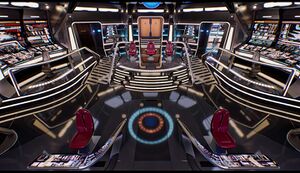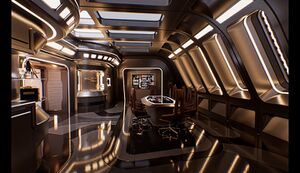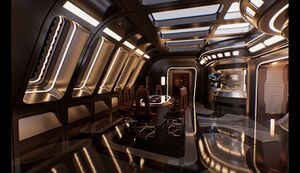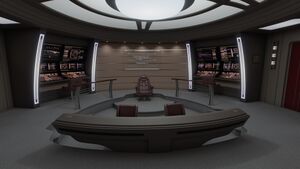User:Kai1701E/squadron/shipdraft
More actions
- "No mater where you go, there you are."
- —Buckaroo Banzai - Ship's Dedication Quote
USS Excelsior NCC-42037, a prominent name in Starfleet history, continues a legacy spanning over 115 years. As the fourth ship in its lineage, the Excelsior II-class has endured as a vital component of the fleet for more than a century. Originally christened as the USS Guardian almost 70 years ago, the vessel underwent a renaming ceremony following the loss of its predecessor during the tragic Frontier Day incident. This renaming was not only a mark of honor but also a testament to Starfleet's commitment to preserving this prestigious lineage.
The USS Excelsior NCC-42037, an Excelsior II-class heavy cruiser, represents a contemporary and versatile upgrade to the iconic Excelsior-class starships of yesteryears. Launched from Avalon Fleet Yards, this vessel now holds the distinction of serving as the flagship of Excelsior Squadron (alongside the starships Buran and Osiris within Task Force 47. Under the capable command of Fleet Captain Keziah Nazir, Excelsior stands ready to carry on the proud tradition of its namesake, embodying the spirit of exploration and service that has become synonymous with the Excelsior lineage.
Mission Objectives
A multi-purpose starship well into her tour of duty, Excelsior has completed a wide variety of tasks and missions assigned to her over the years. Some of her core duties, commensurate with her class as a whole, include:
- Operating autonomously under the command of the commanding officer, providing full capability to execute Federation defensive, cultural, scientific, and explorative policy in deep space or along border territories.
- Replacing aging starships in certain frontline diplomatic and exploration duties.
- Providing a platform for extended scientific survey and scouting missions.
- Providing frontline support during times of war or crisis, such as the Century Storm and Blood Dilithium situations, and situations diplomatic in nature.
- Serving non-critical functions such as transport of personnel and cargo when necessary, extended aid, and short-range patrol.
Technical Configuration
Main Article: Excelsior II-class Heavy Cruiser
Key Location Data
- Main Article: Excelsior deck listing
- Main Article: Tour of the Excelsior
With 24 decks, the ship has hundreds of rooms and locations that serve a variety of purposes for the crew. Some of the more notable locations include:
Bridge

A reflection of the time period she was created, the Excelsior II-class' polished steel, cool metal fixtures and her bridge aesthetics bring back memories of years gone by, her design blending modern technological advancements with the nostalgia of eras long gone. It is a functional, yet aesthetically pleasing facility designed in a similar vein to the rest of the ship. Her greatest feature is a wide-angled window which fills the forward bulkhead. This window has holographic projectors built into the rim, giving it the ability to function as a more traditional viewscreen. It can also be used as an emergency evacuation hatch, with forcefields being lowered until replaced by a large, external bulkhead.
Dominating the heart of the command center, three command chairs made of red leather sit atop the central platform, colloquially known as the 'Command Deck', surrounded by rails and steps to the lower levels of the bridge. As is tradition, the center seat and its controls are reserved for the commanding officer, or any directly appointed officer in command during her absence. To her right, the executive officer and, to her left, a third seat is generally reserved for the use of the ship's Counsellor, Chief Medical Officer or any official or dignitary the Captain sees fit. All three of the chairs have built-in controls on the armrests, enabling the occupying officers to conduct their duties with unprecedented access to a wide variety of ship systems.

At the foot of the stairs directly ahead (or to the side) of the command deck, the 'Flight Deck' consists of two angled consoles serving as duty stations for operations (port) and flight operations (starboard). A few feet from each, two stand-alone consoles provide auxiliary station access for any purpose required (such as communications, environmental control, mission operations etc). Ascending the stairs on either side of the command deck, the port side bulkhead is home to three large stations dedicated to tactical operations, providing access to the ship's defensive and offensive systems, whilst the starboard bulkhead is dedicated to the various science departments on the ship.

Aft of the bridge, there are two additional consoles behind the command area designated for medical use (port) and engineering (starboard), allowing the engineer on duty access to the same engineering systems as in main engineering itself, including access to environmental controls, propulsion systems and the warp core. Central to the aft bulkhead, open access is granted to the observation lounge, which is sealable by emergency bulkheads and forcefields.

Observation Lounge
A beautifully designed room, the observation lounge matches the aesthetic of the rest of the ship, with polished alloys and cool metals as the material of choice during construction. The room is dominated by a large table with holographic controls which is particularly useful for briefings and has seating for up to 10 officers. The Captain traditionally sits closest to the wall-mounted display on the starboard bulkhead. There are several shelves with ornaments and models of previous ships called Excelsior, as well as the original USS Excelsior ship plaque. An additional door provides access from the port bulkhead.
The observation lounge operates an open-door policy and, in the absence of a more traditional ready room attached to the bridge, the Captain often uses the observation lounge as a workspace so that they do not have to return to their quarters, where their actual office is located.
Auxiliary Craft
Shuttlebay 1 - Main Shuttlebay
Shuttlebay 1, or the Upper Shuttlebay, has been modified to house all of the auxiliary craft that make up Azure Flight. These auxiliary craft are made up of some of the most advanced small vessel designs ever to serve Starfleet.
Centaurus, Gliese, Normae, Ithaca
Cassiopeia, Procyon
Achernar, Basri
Shuttlebay 2 - Runabout Landing Bay
Shuttlebay 2 is the smallest of the auxiliary craft facilities on Excelsior and is the permanent home of two Arrow-class runabouts. Due to their size, these vessels cannot be shifted between bays using elevators, so they stay permanently docked in the lower shuttlebay.
Kaeden, Kirsen
Historical Data Records
Recomissioning
Arriving at Avalon Fleet Yards in 2398 as the USS Guardian, the next time the ship would leave dock she would be rechristened with a new name and a new command crew. When she entered dock for her significant overhaul, the Excelsior Refit-class starship had served the fleet for nearly 70 years, seeing action in countless engagements and completing hundreds of varied missions.
Following the unexpected destruction of the USS Excelsior during the Frontier Day debacle, Starfleet realised this would be the first time in over a century that there wasn't an Excelsior in service or under construction as a replacement. Deeming it worth the work, Command authorised the Guardian to be rechristened as the USS Excelsior during her refit, thus becoming the fourth ship to bear the iconic name. Command of Excelsior fell to Fleet Captain Keziah Nazir, formally of the USS Hathaway, which had suffered extensive damage during the Lost Fleet Campaign and the Frontier Day calamity. With Hathaway slated to be in dock for an unspecified amount of time, Starfleet Command reassigned Nazir and her command crew to new postings, and a new squadron. As per their orders from Admiral Grayson, Excelsior would soon launch and make her way to the Thomar Expanse to begin operations with the Pathfinders task force.
The Excelsior Lineage
Like many starships in the Federation fleet, the Excelsior name has endured long after the first ship to bear the name left dock for the first time. Information about past incarnations includes:
- USS Excelsior — Excelsior-class heavy cruiser — NCC-2000
- 2285—2320 (Preserved at the Fleet Museum until 2401)
- USS Excelsior — Excelsior Refit-class heavy cruiser — NCC-27445
- 2320-2389 (Decommissioned)
- USS Excelsior — Excelsior II-class heavy cruiser — NCC-42037
- 2389-2401 (Destroyed)
- USS Excelsior — Excelsior II-class heavy explorer — NCC-42037
- 2401—Present (USS Guardian recommissioned, currently in service)
Commanding Officer Lineage
Notable crewmembers include:
- 2389 - 2394: Captain Benbassat, (Human Male)
- 2394 - 2401: Captain Jason Hawk, (Human Male)
- 2401-2401: Captain Benbassat, (Human Male)
- 2401 - Present: Captain Keziah Nazir, (Trill Female)
- "The only way to discover the limits of the possible is to go beyond them into the impossible. "
- —Arthur C. Clarke - Ship's Dedication Quote
The USS Buran has a storied history that spans multiple decades in each of the last three centuries, establishing its enduring legacy in Starfleet. Originating in the 2250s as a Cardenas-class starship, it was the first in a line of vessels to bear the name. The current iteration, the third USS Buran, belongs to the sleek and agile Rhode Island-class, reflecting its versatility and adaptability in the ever-changing cosmos.
Commissioned in the year 2380, the USS Buran has been designed to excel in various roles. Its remarkable speed and agility make it a prime candidate for fast exploration missions, enabling rapid mapping of uncharted territories. Simultaneously, the vessel boasts powerful sensor platforms, making it a formidable tactical scout capable of identifying potential threats with precision.
Recently relaunched from Avalon Fleet Yards following a minor refit, which coincided with the conclusion of Frontier Day, the USS Buran is now at the forefront of Task Force 47's Excelsior Squadron. Under the capable command of Captain Romaes Anjin, the Buran stands ready to uphold its storied legacy, embodying the spirit of exploration, tactical prowess, and service that has defined the Buran lineage for centuries.
Mission Objectives
With it's increased armament and warp capabilities, the Rhode Island Class|Rhode Island-class USS Buran]] is considered as a Scout/Escort Type Vessel in which their mission objects include all of the standard Nova-class, along with a few extra:
- Provide a platform for extended scientific survey and scouting missions.
- Provide autonomous capability for full execution of Federation defensive, cultural, scientific, and explorative policy in deep space or border territory.
- Serve as a frontline support vehicle during emergencies and a platform for the extension of Federation diplomacy and policy.
- Provide non-critical functions such as transport of personnel and cargo when necessary, extended aid, and short-range patrol.
- Provide a multi-mission mobile platform for a wide range of scientific and explorative research, and diplomatic projects.
- Provide autonomous capability for full execution of Federation defensive, cultural, scientific, and explorative policy in deep space or border territory.
Technical Configuration
Main Article: Rhode Island-class Scout
Key Location Data
- Main Article: Buran deck listing
- Main Article: Tour of the Buran
With only 8 decks and short term missions to complete, the 90 crew of the Buran have a relatively comfortable standard of living, despite the close quarters they share.
Bridge
Modelled on the successful layout of other small vessels such as the Nova and Saber-class starships, the bridge of the Buran has a slightly altered colour scheme and a much-changed console layout across the bridge. Making the most of a variety of technological advancements, such as holoprojectors, holographic communications, in-built weapons lockers and three-dimensional computer displays in places, the Rhode Island-class bridge module is one of the most advanced in the pre-2400 fleet. Perhaps one of its most charming features is the glass MSD on the back feature wall which is entirely customisable and interactive.

In a move away from more recent styles, and harking back to the traditional layouts of yesteryear, the Buran has a single center command seat for the commanding officer allowing the occupant full view of all stations. Directly ahead of them, down a few steps and between the commanding officer and the holographic viewscreen, two consoles have been merged into one single station, serving as duty stations for Operations (port) and Flight Operations (starboard). Surrounding the bridge, an additional four duty stations make up the rest of the command center's capacity. On the starboard bulkhead, two stations are dedicated to science (forward) and mission operations (aft), while on the port bulkhead, stations are reserved for tactical operations (forward) and engineering (aft).
Around the command center, two doors provide access to and from the bridge. On the starboard bulkhead, access is available to the ready room, observation lounge and the rest of deck 1 (including an emergency turbo lift to engineering and sickbay), whilst the port door grants access to the rest of the ship.
Auxiliary Craft
Shuttlebay
Due to the small size of the Buran, she has a single shuttlebay aft of the ship that houses just one runabout and two shuttles, all named after locations or ships used as part of the Russian Buran Spacecraft Project.
Baikonur, Ptichka
Aelita
Historical Data Records
Commissioned in the later years of the 24th century, the USS Buran, a Rhode Island-class scout and science vessel, stands as a testament to Starfleet's commitment to exploration, scientific advancement, and defense. Her construction took place between 2380 and 2383, during a period marked by significant technological innovation in starship design. Launched in 2383, the Buran embarked on a journey that would be defined by its contributions to knowledge, discovery, and service to the United Federation of Planets.
The sleek and versatile design of the Buran, typical of the Rhode Island-class, made her a versatile asset within Starfleet's fleet. This starship was equally proficient as a fast and agile exploration platform, capable of swiftly charting unexplored territories, and as a scientific vessel, equipped with cutting-edge sensor arrays and research laboratories for conducting groundbreaking experiments and studies.
In the year 2401, the USS Buran found herself in Avalon Fleet Yards for minor repairs and upgrades. This maintenance period followed the conclusion of Frontier Day, a pivotal event that tested the mettle of Starfleet's starships and crews. It was during this time that the Buran's command was reassigned to Captain Romaes Anjin, a seasoned officer known for his leadership and strategic prowess. Joining him was Commander Tharia sh'Elas, whose expertise in scientific endeavors made her a valuable addition to the command team.
The transfer of the USS Buran to Excelsior Squadron of Task Force 47, the Pathfinders task force, marked a new chapter in her history. Task Force 47 was renowned for its missions at the forefront of exploration and discovery, making it a fitting assignment for a vessel with the Buran's capabilities.
The Buran Lineage
Like many starships in the Federation fleet, the Buran name has endured long after the first ship to bear the name left dock for the first time. Information about past incarnations includes:
- USS Buran — Cardenas-class fast cruiser — NCC-1422
- 2250—2256 (Destroyed - Battle of Priors World)
- USS Buran — Challenger-class scout — NCC-57580
- 2355-2366 (Destroyed - Battle of Wolf 359)
- USS Buran — Rhode Island-class scout — NCC-81711
- 2380—Present (In Service)
Commanding Officer Lineage
Notable crewmembers include:
- 2401 - Present: Captain Romaes Anjin, (Bajoran Male)
- "No mater where you go, there you are."
- —Buckaroo Banzai - Ship's Dedication Quote
USS Osiris NCC-86401, a Reliant-class frigate, stands as a unique and revered addition to Starfleet, as she is the first vessel to bear this illustrious name, inspired by the Egyptian god of the afterlife and rebirth. In 2392, Osiris was commissioned as one of the pioneers of her class, symbolizing Starfleet's commitment to maintaining peace and order along its borders and spacelanes. However, her journey through the cosmos was not without challenges. Engaging in several intense skirmishes with Dominion forces and enduring the harrowing events of the Frontier Day disaster, Osiris found herself in need of significant repairs and crew replacements. It was during this time that she underwent extensive maintenance at Avalon Fleet Yards.
A new chapter in Osiris's history unfolded with the arrival of Captain Giarvar Kauhn, previously of the Arimathea, who assumed command of the ship. This experienced leader brought with him a wealth of knowledge and strategic acumen that was well-suited to the challenges that lay ahead. Osiris's mission profile underwent a transformation as well, as she was transferred to Task Force 47 within the Fourth Fleet, becoming an integral part of the newly established Excelsior Squadron.
Mission Objectives
A multi-purpose starship still relatively new, Osiris has already completed a wide variety of tasks and missions assigned to her over the years since she launched. Some of her core duties, commensurate with her class as a whole, include:
- Provide a mission specific mobile platform for a wide range of diplomatic, scientific, or explorative projects.
- Supplement starships such as the Excelsior II-class as an instrument of the Federation deep-space defensive, scientific or diplomatic presence.
- Provide autonomous capability for full execution of Federation defensive, cultural, scientific, and explorative policy in deep space or border territory.
- Serve as a frontline support vehicle during times of war and emergencies.
- Provide a mobile platform for testing and implementation of mission-specific or new technology of any kind.
Technical Configuration
Main Article: Reliant-class Frigate
Key Location Data
- Main Article: Reliant deck listing
- Main Article: Tour of the Reliant
With 24 decks, the ship has hundreds of rooms and locations that serve a variety of purposes for the crew. Some of the more notable locations include:
Bridge
Modelled on the successful layout of older, larger vessels such as the Sovereign-class, the bridge of the Osiris has a slightly altered colour scheme and a much-changed console layout across the bridge. Making the most of a variety of technological advancements, such as holoprojectors, holographic communications, in-built weapons lockers and three-dimensional computer displays in places, the Reliant-class bridge module is one of the most advanced in the fleet. Perhaps one of its most charming features is the emblem of the United Federation of Planets emblazoned on the carpeting as a constant reminder of all the ship stands for.

In a move away from more recent styles, and harking back to the traditional layouts of yesteryear, the Osiris has a single center command seat for the commanding officer allowing the occupant full view of all stations. Directly ahead of them, down a few steps and between the commanding officer and the holographic viewscreen, two angled consoles serve as duty stations for Operations (port) and Flight Operations (starboard). Next, and facing into the heart of the bridge to allow maximum participation with the rest of the bridge crew are duty stations for science (port) and tactical operations (starboard). Directly behind the commanding officer, and in a further break from tradition, a combined duty station serves as positioning for the two most senior advisors and assistants to the ship's commander; the Executive Officer (starboard) and, when appropriate, the mission advisor or specialist (port). Around the outside of the bridge, there are countless other additional stations. Behind the main science station on the port bulkhead, additional science and medical consoles are available for mission operations, as well as access to life support and environmental controls. Adjacent to them on the starboard bulkhead, mission operations and security stations ensure the continued safety of the ship and crew on a day-to-day, mission-by-mission basis. On the aft bulkhead, engineering is the focus. With a large, entirely interactive and customizable master systems display (MSD) and other engineering controls, the representative from engineering has full access to the ship's systems.
Around the command center, four doors provide access to and from the bridge. On the forward port bulkhead, access is available to the observation lounge, whilst the starboard door grants access to the commanding officer's private ready room (available for use by any officer in command of the ship). At the aft of the bridge, both doors provide access to turbo lifts which enable the crew to access the command center from the rest of the bridge. The starboard turbo lift grants express, overridden access to key locations such as engineering, shuttlebay 1, sickbay, tactical astrometrics and transporter rooms 1 and 2.
Auxiliary Craft
Shuttlebay 1 - Main Shuttlebay
Shuttlebay 1, or the main shuttlebay, houses the shuttlecraft part of the auxiliary craft compliment on Osiris. These auxiliary craft are made up of some of the most advanced small vessel designs ever to serve Starfleet.
Isis, Nephthys
Shuttlebay 2 - Runabout Landing Bay
Shuttlebay 2 is identical to shuttlebay 1 and is the permanent home of a single Arrow-class runabout.
Horus
Historical Data Records
Pre-Frontier Day
Commissioned in an era marked by both challenges and opportunities, the USS Osiris, a Reliant-class frigate, embodies the spirit of exploration and vigilance that defines Starfleet. Her construction spanned from 2389 to 2392, a testament to the dedication and ingenuity of the Federation's starship engineers. Launched in 2392, the Osiris embarked on a mission to safeguard the Romulan border region, a region of strategic importance in the ever-changing political landscape of the galaxy. Over the course of nearly a decade, the Osiris operated diligently along the Romulan border, fulfilling her role as a sentinel of peace and stability in a volatile region. Her crew displayed unwavering dedication, conducting patrols, maintaining watchful eyes on potential threats, and participating in diplomatic missions that sought to foster cooperation and understanding.
However, the Osiris was soon thrust into the crucible of conflict. In the Dominion conflict of the Deneb sector, she faced the challenges of war head-on. Her crew demonstrated remarkable resolve and valor, standing firm against Dominion forces and contributing to the defense of Federation interests in the sector.
The Osiris's journey through adversity reached its zenith at Frontier Day, an event that would leave an indelible mark on her history. Tragically, during a confrontation with the relentless Borg, the ship's commanding officer was killed in action. The loss of their leader was a heavy blow to the crew, yet they continued to persevere in the face of adversity.
Post-Frontier Day
Following the harrowing events of Frontier Day, the Osiris docked at Avalon Fleet Yards for much-needed minor repairs. This respite provided an opportunity for crew replacements and a change in command. With the USS Arimathea slated for decommissioning, Captain Giarvar Kauhn assumed the mantle of leadership, bringing his wealth of experience and leadership qualities to the ship. Commander Noli Auru, as the executive officer, partnered with Captain Kauhn to lead the ship into a new era.
The Osiris's mission profile underwent a transformation as she was integrated into Task Force 47's Excelsior Squadron, signifying her role in the broader strategic framework of Starfleet's operations. Under the capable command of Captain Kauhn and the guidance of Commander Auru, the USS Osiris stood ready to continue her legacy as a beacon of vigilance and a symbol of the Federation's commitment to peace, even in the face of the galaxy's most formidable challenges.
Commanding Officer Lineage
Notable crewmembers include:
- 2401 - Present: Captain Giarvar Kauhn, (Trill Male)
